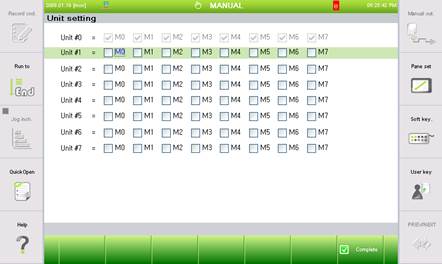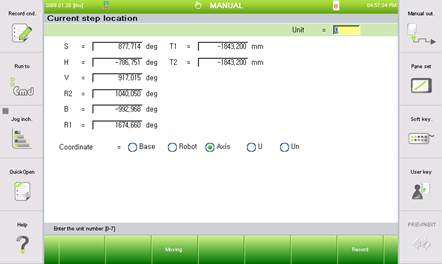7.5.7. Unit setting
7.5.7. Unit setting
Unit refers to setting the combination of axes that can be moved by the task program. Through this message box, you can set each unit with various combinations of mechanisms.
A mechanism is the combination of individual axes, so, consequently, a unit is also the combination of individual axes. However, there is difference because mechanism is used during the jog activity, while the unit is used for recording the step position in the program. In general conditions, a unit is set as being unit#0, which signifies the state in which all mechanisms are included, meaning the state in which all axes are included. In this state, if the robot program is recorded, the positions of all of the axes are recorded. During the playback, all the axes move to those positions.
If the user wants to prepare a program that will run only some specific mechanisms (axes), units need to be assigned through this menu and used.
(1) Because the unit change of the system has a big impact to the operation of the controller, only the engineer can set it up and make changes.
(2) Select 『[F2]: System』 → 『5: Initialize』 → 『7: Unit setting』from the initial screen of the manual mode.

Figure 7.57 Unit setting
(3) Unit #0 is fixed to all mechanism.
(4) For unit #1 to #7, the user can select various mechanisms.
(5) In order to record a step of a program in a manual mode, the user can select the unit number using the [Unit] key and can press the [REC] key to save only the location of the axis relevant to the unit.
(6) When you press the [POS. MOD] key from the recorded step, the location of the unit saved on the step will be changed.
(7) If you proceed the step by changing or executing the step with the cursor, the current unit number recorded will automatically change to the unit number recorded on the step.
l Refer to the following function related to the unit.
① You can change the unit of pose parameter. (Ex, “P1.Unit=2”)
② You can designate the unit of the pose constant. (Ex, “P1=(12.00,13.00)UNIT2”)
③ When you look at the task program from the PC, the unit is included in the hidden pose.
(Ex, “S3 MOVE, P,S=50%,A=0,T=0 (12.00,27.00)UNIT2” )
(When the unit is 0, UNIT0 is not included.)
l Robot coordinates interpolation function (Applied since MV31.06)
1) Conditions for the usage of this function:
① At a system with a travelling axis, a unit with a travelling axis needs to be set, and the coordinates for the step should be set as ‘Robot’.
② In case of the system with a travelling axis, the processing should take place while differentiating between the step (Support only the base coordinates interpolation) that includes a travelling axis and the step (Support only the robot coordinates interpolation) that does not include a travelling axis
è Non-applicable for a system that has no travelling axis.

Figure 7.58 Robot coordinates setting for the step
2) Explanation about the function:
① If the unit of a step is set as ‘robot only.’
- The coordinates are recorded as ‘robot’ or ‘axis angle
è The liner interpolation (L) and the circular interpolation (C) need to be executed based on the coordinates of the robot. .
- If the coordinates are recorded as ‘base’, when playing back is in progress, it will be handled as an error.
è “E1483 Setting of the coordinate system and unit of step doesn't match.” error occurs.
- It is impossible to execute the stationary tool interpolation, the conveyor synchronization and the positioner synchronization.
è“E1484 Error in unit setting - Unable to use synchronous feature” error occurs.
② If the unit of a step is set as ‘all travelling axes + robot”
-If the coordinates are recorded as ‘base’ or ‘User U, Un’
è The L and C interpolation should take place using the designated ‘base coordinates’ or ‘user coordinates’. The robot coordinates interpolation (L, C) is not to be supported. .
- However, if the unit is ‘travelling axis + robot’, all the travelling axes are included in the unit. When there are multiple travelling axes, they need to be included in the unit. If not, it will be considered as ‘robot only’.
3) How to use the function
① Even when the standalone operation needs to take place by using the ‘multitasking’ or ‘command standalone execution’ function needs to be used, the operation will be possible when operating through the L and C interpolations.
② When the unit function is used, the robot coordinates P, L and C interpolations will be possible.
- Support for the servo gun and Eqless gun
- Support for the shift function
③ A program can be prepared in an instinctive and simple manner.
- It will be made easier to prepare a program that can carry out the same work only shifting the base axis.
- It will be made easier to prepare a program that can carry out the gun search regardless of the location of the base axis.